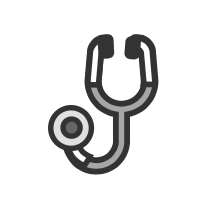Thyroid Examination (OSCE)
What is thyroid hormone T3?
 A hormone which, alongside T4, regulates the body’s cellular functioning, controlling its metabolism, heart rate and temperature
A hormone which, alongside T4, regulates the body’s cellular functioning, controlling its metabolism, heart rate and temperature
 When T3 is not bound to a protein, it is called ‘circulating T3’
When T3 is not bound to a protein, it is called ‘circulating T3’
 High levels of circulating T3, raises the metabolism, causing weight loss and potentially, excessive sympathetic output (anxiety, tremor, tachycardia) ⬇
High levels of circulating T3, raises the metabolism, causing weight loss and potentially, excessive sympathetic output (anxiety, tremor, tachycardia) ⬇
 Low levels of circulating T3, lowers the metabolism, causing weight gain, constipation, low mood, hyporeflexia and bad memory ⬆
Low levels of circulating T3, lowers the metabolism, causing weight gain, constipation, low mood, hyporeflexia and bad memory ⬆
Introduction
- Greet patient and introduce yourself
- Confirm patient details ✍
- Briefly explain the examination in a patient friendly manner
- Get patient consent ✅
- Wash hands ✋
- Expose patient’s upper sternum and neck
- Check the patient is not in any pain
Equipment
 Tendon hammer
Tendon hammer
 Stethoscope
Stethoscope 
 Glass of water
Glass of water
 Paper
Paper
Inspect the patient for any clinically relevant signs:
 Behaviour: hyperactivity and anxiety indicate hyperthyroidism, low mood indicates hypothyroidism
Behaviour: hyperactivity and anxiety indicate hyperthyroidism, low mood indicates hypothyroidism
 Weight: weight loss indicates hyperthyroidism, weight gain indicates hypothyroidism
Weight: weight loss indicates hyperthyroidism, weight gain indicates hypothyroidism
 Voice: hoarse sounding voice indicates thyroid enlargement causing larynx compression
Voice: hoarse sounding voice indicates thyroid enlargement causing larynx compression
 Clothes: too cold for the temperature indicates hyperthyroidism, too warm for the temperature indicates hypothyroidism
Clothes: too cold for the temperature indicates hyperthyroidism, too warm for the temperature indicates hypothyroidism
Identify any clinically relevant objects/equipment:
 Prescriptions: indicate recent medications 💊
Prescriptions: indicate recent medications 💊
 Mobility aids: indicate proximal myopathy caused by hyperthyroidism ♿
Mobility aids: indicate proximal myopathy caused by hyperthyroidism ♿

Hands
Inspect the patient’s hands:
 Onycholysis: hyperthyroidism can cause the nail to detach from the nail bed (painless)
Onycholysis: hyperthyroidism can cause the nail to detach from the nail bed (painless)
 Dry skin: caused by hypothyroidism
Dry skin: caused by hypothyroidism
 Palmar erythema: hyperthyroidism can cause red palms ✋
Palmar erythema: hyperthyroidism can cause red palms ✋
 Thyroid acropachy: periosteal phalangeal bone overgrowth due to Graves’ disease
Thyroid acropachy: periosteal phalangeal bone overgrowth due to Graves’ disease
 Sweating: hyperthyroidism can cause patients to sweat excessively
Sweating: hyperthyroidism can cause patients to sweat excessively
Assess for peripheral tremor:
- Ask patient to stretch their arms out in front of them, palms facing the floor ✋
- Put a piece of paper on the back of their hands
- Identify the tremor by observing whether the paper shakes
Radial Pulse
Use your index and middle fingertips to palpate the radial pulse:
 Assess the rate and rhythm of the pulse 💓
Assess the rate and rhythm of the pulse 💓
 Calculate the heart rate
Calculate the heart rate
 Healthy: 60-100 bpm
Healthy: 60-100 bpm
 Bradycardia: <60 bpm
Bradycardia: <60 bpm
 Tachycardia: >100 bpm
Tachycardia: >100 bpm
 Irregular rhythm: atrial fibrillation
Irregular rhythm: atrial fibrillation
Face
Inspect the face:
 Eyebrow loss: the outer third of eyebrows is occasionally missing in hypothyroid patients
Eyebrow loss: the outer third of eyebrows is occasionally missing in hypothyroid patients
 Dry skin: indicates hypothyroidism
Dry skin: indicates hypothyroidism
 Sweating: indicates hyperthyroidism
Sweating: indicates hyperthyroidism
Eyes:
 Assess for pathology indicative of Graves’ disease
Assess for pathology indicative of Graves’ disease
 Lid retraction: inspect from front, indicated by the sclera being visible between the corneal limbus and upper lid margin 👁
Lid retraction: inspect from front, indicated by the sclera being visible between the corneal limbus and upper lid margin 👁
 Exophthalmos: inspect from front, side and above, indicated by the eye bulging anteriorly 👁
Exophthalmos: inspect from front, side and above, indicated by the eye bulging anteriorly 👁
 Inflammation: the eye is more prone to dryness, conjunctivitis, conjunctival oedema or corneal ulceration, when lid retraction and exophthalmos are present
Inflammation: the eye is more prone to dryness, conjunctivitis, conjunctival oedema or corneal ulceration, when lid retraction and exophthalmos are present
 Movement: Graves’ disease can cause restriction (ophthalmoplegia) and pain when moving the eye, assessed by asking the patient to follow your finger
Movement: Graves’ disease can cause restriction (ophthalmoplegia) and pain when moving the eye, assessed by asking the patient to follow your finger
 Lid lag: this is when there is a delay between the eyeball moving to look downwards, and the upper eyelid doing so, assess by asking the patient to follow your finger downwards ⬇
Lid lag: this is when there is a delay between the eyeball moving to look downwards, and the upper eyelid doing so, assess by asking the patient to follow your finger downwards ⬇
Thyroid
 Inspect the midline of the neck to identify any scars/masses
Inspect the midline of the neck to identify any scars/masses
Inspecting a mass:
 Ask patient to swallow some water as you assess how the mass moves
Ask patient to swallow some water as you assess how the mass moves
 Lymph nodes: move very little ❌
Lymph nodes: move very little ❌
 Thyroid gland masses/thyroglossal cysts: move upwards ⬆
Thyroid gland masses/thyroglossal cysts: move upwards ⬆
 Invasive thyroid malignancy: no movement (attached to tissue) ❌
Invasive thyroid malignancy: no movement (attached to tissue) ❌
Ask patient to stick their tongue out:
 Thyroid gland masses/lymph nodes: no movement ❌
Thyroid gland masses/lymph nodes: no movement ❌
 Thyroglossal cysts: move upwards ⬆
Thyroglossal cysts: move upwards ⬆
Palpation of the thyroid
- Ask patient to tilt chin downwards ⬇
- Stand behind patient and place your 3 middle fingers of both hands, below the chin, on the midline of the patient’s neck
- Identify the upper edge of the patient’s ‘Adam’s apple’ (thyroid cartilage)
- Lower your fingers to the cricoid cartilage to find the overlying thyroid isthmus ⬇
- Palpate the thyroid isthmus
- Move your fingers outwards on both sides to palpate the thyroid lobes
- Keep your fingers on the thyroid lobes as the patient swallows water, assessing the movement (they should elevate symmetrically, asymmetrical elevation indicates a possible unilateral thyroid mass)
- Assess for mass by asking patient to stick their tongue out, a thyroglossal cyst which rise ⬆
Thyroid gland characteristics:
 Symmetry: identify asymmetry
Symmetry: identify asymmetry
 Size: identify enlargement ⬆
Size: identify enlargement ⬆
 Masses: identify palpable masses
Masses: identify palpable masses
 Consistency: identify irregularities
Consistency: identify irregularities
 Palpable thrill: caused by hyperthyroidism, causing increasing the thyroid gland to become more vascularised
Palpable thrill: caused by hyperthyroidism, causing increasing the thyroid gland to become more vascularised
Thyroid mass identification:
 Assess the shape, consistency, mobility and position:
Assess the shape, consistency, mobility and position:
 Thyroglossal cyst: congenital, due to thyroglossal duct persistence, rise when tongue is protruded
Thyroglossal cyst: congenital, due to thyroglossal duct persistence, rise when tongue is protruded
 Diffuse goitre: thyroid gland enlarged due to thyroid tissue hyperplasia
Diffuse goitre: thyroid gland enlarged due to thyroid tissue hyperplasia
 Uninodular goitre: single thyroid nodule, active (toxic, causing hyperthyroidism) or inactive
Uninodular goitre: single thyroid nodule, active (toxic, causing hyperthyroidism) or inactive
 Multinodular goitre: multiple thyroid nodules, active or inactive
Multinodular goitre: multiple thyroid nodules, active or inactive
Palpation of lymph node:
 Local lymphadenopathy can indicate primary thyroid malignancy metastatic spread
Local lymphadenopathy can indicate primary thyroid malignancy metastatic spread
- Ask patient to tilt chin downwards ⬇
- Standing behind patient, palpate neck
- Assess lymph node characteristics simultaneously by using the pads of the fingers on both hands to roll the lymph nodes over the tissue surrounding them
- Assess all areas, beginning in the submental:
 Submental
Submental
 Submandibular
Submandibular
 Pre-auricular
Pre-auricular
 Post-auricular
Post-auricular
 Superficial cervical
Superficial cervical
 Deep cervical
Deep cervical
 Posterior cervical
Posterior cervical
 Supraclavicular
Supraclavicular
Trachea
 Observe if the trachea is deviated, possibly due to a goitre
Observe if the trachea is deviated, possibly due to a goitre
Percuss the sternum
 Assess for retrosternal dullness by percussing from the sternal notch, downwards ⬇
Assess for retrosternal dullness by percussing from the sternal notch, downwards ⬇
 Retrosternal dullness can indicate a large thyroid mass
Retrosternal dullness can indicate a large thyroid mass
Auscultate the thyroid gland
 Use the bell of the stethoscope to auscultate the lobes of the thyroid gland and identify the presence of a bruit which is indicative of increased vascularity (Graves’ disease)
Use the bell of the stethoscope to auscultate the lobes of the thyroid gland and identify the presence of a bruit which is indicative of increased vascularity (Graves’ disease) 

More tests
Assess the biceps or knee jerk reflex:
- Place your thumb over the patient’s relaxed brachii tendon
- Tap thumb with tendon hammer
- Assess whether the bicep contracts and elbow flexes 💪
 Reflexes allow you to identify hyporeflexia indicative of hypothyroidism 💪
Reflexes allow you to identify hyporeflexia indicative of hypothyroidism 💪
Pretibial myxoedema:
 Diffuse mucinosis
Diffuse mucinosis
 Presents as a waxy, discoloured hardening of skin on the shin
Presents as a waxy, discoloured hardening of skin on the shin
 Rare Graves’ disease complication
Rare Graves’ disease complication
Proximal myopathy:
 Can indicate multinodular goitre or Graves’ disease
Can indicate multinodular goitre or Graves’ disease
 Wastage of proximal muscles 💪
Wastage of proximal muscles 💪
 Causes difficulty standing up (ask patient to sit then stand up whilst crossing their arms)
Causes difficulty standing up (ask patient to sit then stand up whilst crossing their arms)
Completion
- Tell the patient the examination is complete ✅
- Thank patient
- Wash hands ✋
- Summarise what the examination has revealed
Summary
- Greet the patient and explain the procedure
- Inspect the patient to identify anything clinically relevant
- Inspect and assess the patient's hands
- Palpate the radial pulse
- Inspect the face and eyes
- Inspect and palpate the thyroid and inspect and palpate any masses
- Palpate the lymph node
- Assess whether the trachea is deviated
- Percuss the sternum
- Auscultate the thyroid gland
- Perform any necessary additional tests
Related Articles
This step by step guide is designed to take you through the examination of a lump in OSCEs
This step by step guide is designed to take you through the testicular examination in OSCEs.















